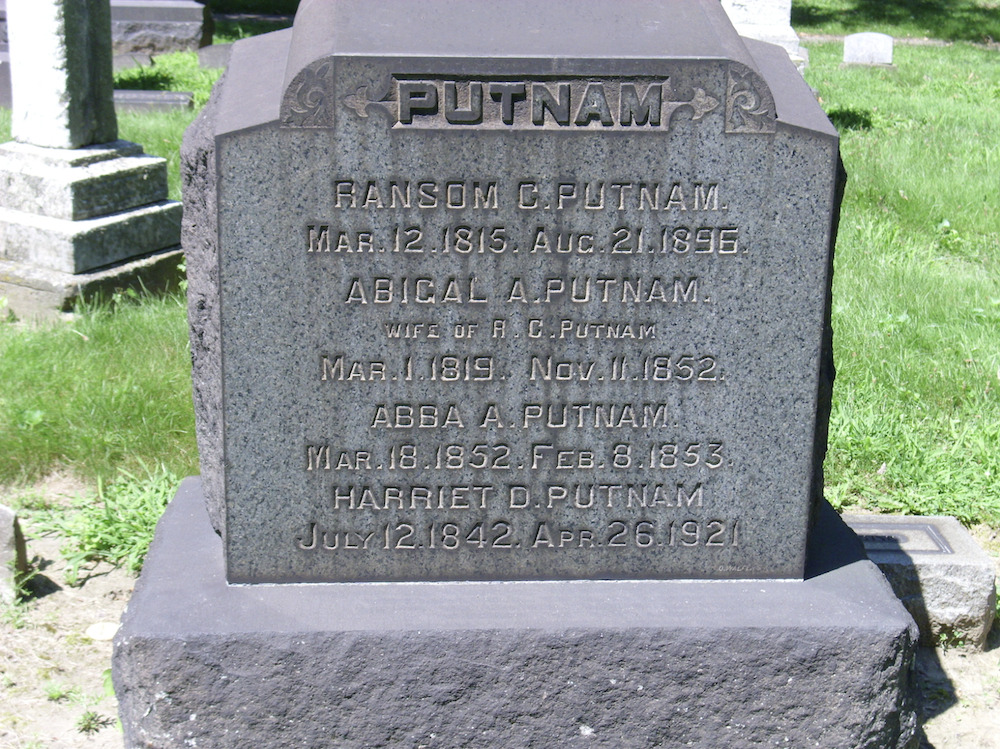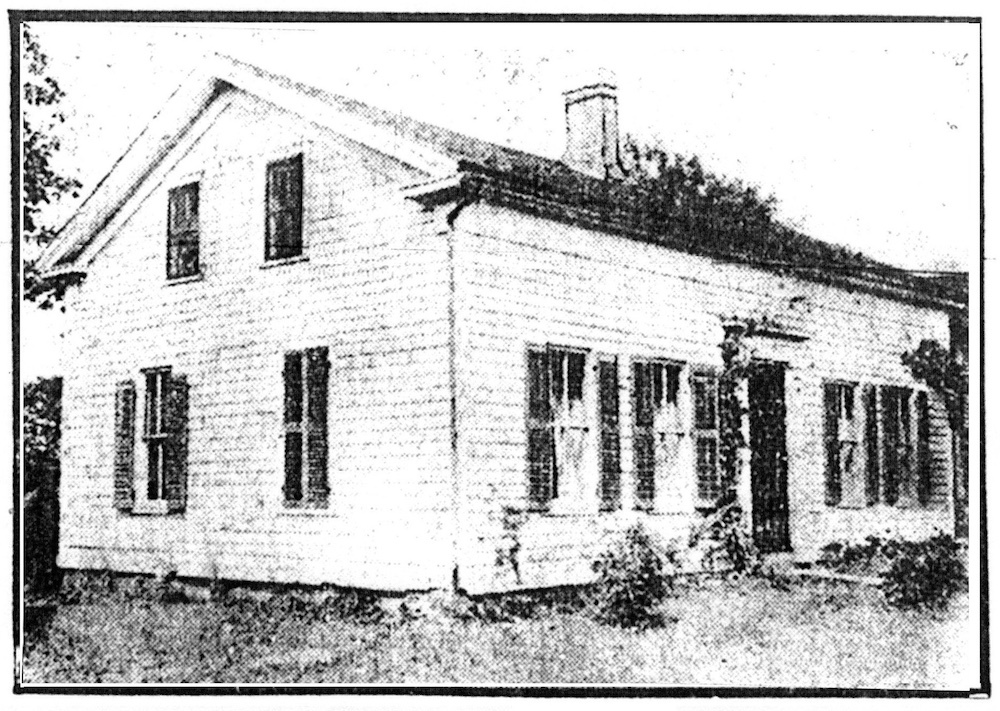Bradford House
Hiding in Plain Sight in Cleveland's Corlett Neighborhood

In October 1904, a reporter for the Cleveland Leader traveled to Newburgh Township to see the house of Charles Putnam on Miles Avenue. Following the visit, he wrote an article about the house, stating that it had been built in 1801, was known locally as the "Bradford Mansion," and was one of the oldest houses still standing in the Western Reserve.
There are many mysteries surrounding the history of the Bradford House at 11715 Miles Avenue, but the question of whether it was built in 1801 is not one of them. While the house is indeed one of Cleveland's oldest, it was clearly not built in that year. Lot 468 in Newburgh Township, the 100-acre lot upon which the house at a later date was built, was as yet undeveloped and unoccupied. It may have still been owned in that year by the Connecticut Land Company which later, before the formation of Cuyahoga County in 1810, apparently sold it to Oliver Ellsworth, one of America's founding fathers. Ellsworth, who lived in Connecticut and was a delegate to both the 1776 Continental Congress and the 1787 Constitutional Convention, served as one of Connecticut's first two senators and, perhaps most notably, was appointed in 1796 by President George Washington to serve as the third Chief Justice of the United States Supreme Court.
Oliver Ellsworth died in 1807, and in 1816, according to Cuyahoga County deed records, his heirs and their spouses conveyed to Ellsworth's oldest son Martin all of the interest they held in Western Reserve lands which they had inherited from Ellsworth's estate, including Lot 468 in Newburgh Township. In 1833, Martin Ellsworth, who lived in Windsor, Connecticut, sold Lot 468 to Alvin and Grafton Bradford, two cousins from Williamsburg, Massachusetts, a small town in western Massachusetts that was located only 50 miles from Windsor.
In the spring of 1833, Alvin and Grafton Bradford, and their wives—all of them under 30 years of age—left Williamsburg and set out for Newburgh Township, Ohio—some 500 miles away—with the intent to settle and start new lives on Lot 468. They built a house there that year, which a review of county tax records suggests is likely the main section of the house that still stands today at 11715 Miles. Unfortunately, in October 1833, Abigail Bradford, the wife of Alvin, died from a disease she had contracted in Newburgh, according to an obituary appearing in a Boston newspaper. It was possibly cholera which took many lives in northeast Ohio during the Great Cholera Pandemic of 1829-1837. Alvin Bradford departed Newburgh and returned home to Williamsburg to bury his wife. Afterwards, apparently concluding the "West" was no longer for him, he deeded his half interest in Lot 468 to his cousin Grafton.
Grafton Bradford and his wife Charlaine stayed, living in the house the Bradford cousins and their wives had built on Lot 468, farming the land and raising four children there. Tax records also suggest that, in 1846 or 1847, they built the addition still joined to the east side of the house, perhaps in response to the needs of their growing family.
The one and one-half story house built by the Bradfords has been described by some as Greek Revival in architectural style, and indeed houses of that style were being designed and constructed in the United States in the 1830s. However, local architectural historian Craig Bobby has noted that houses as old as this one often lack a "style" and that some would therefore describe this house as "vernacular" rather than Greek Revival. Bobby also indicated that the Ohio Preservation Office considers houses like this one to be examples of a "type" called "Hall and Parlor." Another architectural historian of note, Gary Stretar, who focuses on the architecture of early nineteenth century houses, believes the house is a "classic example of an early 'Western Reserve' style house of possibly the second wave of settlers, maybe 1835-1845." Stretar also noted that such story and a half houses have Greek Revival features and a wing that often contained the work rooms, including a kitchen. He finally noted that "[r]arely does a house of this period survive in an urban setting."
In addition to farming the land he owned in Newburgh Township, Grafton Bradford was active in the Cuyahoga County Total Abstinence Society and also served one year (1841) as a trustee of Newburgh Township. In 1850, perhaps because of increased traffic on the new Cleveland and Chagrin Falls Plank Road which their house fronted, or perhaps because of news that the Cleveland and Mahoning Railroad was planning to soon lay tracks through their farmland, Grafton and Charlaine Bradford sold Lot 468 and moved to Ravenna, in more rural Portage County, where they purchased new farm land and lived out their lives.
The Bradford House and the 100 acre lot upon which it then stood passed through several hands before it was purchased in 1863 by Jesse Bishop, a Cleveland lawyer, judge and real estate speculator. In 1874, Bishop entered into a land development partnership with real estate developer James M. Hoyt and in 1876 they platted a residential subdivision on a portion of Lot 468 which included the land upon which the Bradford House stood. The old house could have been razed or moved by the developers, but instead it, and a little more than one and one-half acres of the land upon which it stood, were purchased by Ransom C. Putnam, a Newburgh farmer, who very possibly wanted to preserve the historic house that his family later referred to as the Bradford Mansion.
Ransom Putnam, who was already fifty-nine years old when he purchased the Bradford House, lived in it until his death in 1896. Less than a year before his death, according to an article appearing in the Cleveland Leader on December 1, 1895, the house was the site of a grand Putnam family reunion, attended by four generations of the Putnam family. Upon Ransom Putnam's death, the house passed to his daughter Harriet Putnam who lived in it for a time with various siblings and nieces and nephews. One of them was Charles Putnam who was living in the house in October 1904 when the reporter from the Cleveland Leader came to visit. Unlike his grandfather and his father William H. Putnam, Charles was not a farmer but instead worked at one of the rolling mills that had come to Newburgh in the second half of the nineteenth century as the area industrialized.
Harriet Putnam owned the Bradford House until her death in 1921, the house then passing to her nephew Ransom Waldeck. All in all, members of the extended Putnam family owned the house from 1874 until 1933, with three generations of the family living there as adults. Over the years, Ransom, and later his daughter Harriet, subdivided the one and one-half acre lot upon which the Bradford House was standing, creating four additional lots on the north side of Miles upon which houses were built. All of these houses were initially occupied by members of the extended Putnam family, as was another adjacent to the west. Other members of the Putnam family lived in several houses across the street from these houses. During the last decade of the nineteenth and first two decades of the twentieth century, there were so many members of the extended Putnam family living on Miles Avenue between East 116th and East 119th Streets that this block could easily have been known—and perhaps locally it was—as Putnam Place.
In 1933, the same year in which the Bradford House likely was becoming a century home, the Ransom family sold it to Anton and Mary Salamon, Slovenian immigrants. The Salamon family owned the house for the next 45 years, and it likely benefited from this family's care, especially while Anton Salamon, a building contractor who was a carpenter by trade, still lived. Over the course of the next two decades, following the Salamon family's sale of the house in 1978, the Bradford House changed owners 12 times before it was purchased in 1997 by Senique Pearl, who still owns the house as of the writing of this story in 2023.With a little bit of luck, and continued care from its current owner, the Bradford House, one of the Corlett neighborhood's most historic houses, may well make it to its 200th birthday in 2033.
Images










In October 1904, a Cleveland Leader reporter traveled to Newburgh Township to visit and then write an article about the Bradford House on Miles Avenue. This photograph was taken during that visit and , along with a story about the house, appeared in the October 16, 1904 edition of the Leader. Source: Cleveland Public Library, Historical Newspaper Collection


